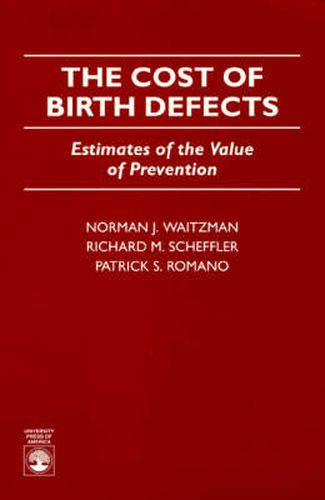Readings Newsletter
Become a Readings Member to make your shopping experience even easier.
Sign in or sign up for free!
You’re not far away from qualifying for FREE standard shipping within Australia
You’ve qualified for FREE standard shipping within Australia
The cart is loading…






This book uses an incidence approach to look at the economic repercussions of birth defects. The authors investigate eighteen of the most clinically significant birth defects affecting 35,000 newborns each year in our country. Their assessments suggest that the annual cost of these eighteen birth defects, together, is more than eight billion dollars (in 1992 dollars). The authors describe in detail their methodology and data sources while providing thorough accounts of each of the eighteen birth defects. Waitzman, Scheffler, and Romano break new ground by using reports from the California Birth Defects Monitoring Program in order to provide cost estimates. They illustrate to the reader how cost estimates of specific birth defects can be used to justify prevention interventions and strategies. In chapter seven, they provide an important example, showing cost-benefit analysis of a program of folate supplementation of food to prevent neutral tube defects. Contents: List of Tables; Preface; Acknowledgements; Introduction; The Application of Cost-of-Illness Methodology To Birth Defects; The Direct Medical Costs of Birth Defects; Nonmedical Direct Costs of Birth Defects: Developmental Services and Special Education; The Indirect Costs of Birth Defects; Premature Mortality and Heightened Morbidity; An Assessment of Total Costs and Policy Implications; Description of Birth Defects; Description of Major Data Sources; Index.
$9.00 standard shipping within Australia
FREE standard shipping within Australia for orders over $100.00
Express & International shipping calculated at checkout
This book uses an incidence approach to look at the economic repercussions of birth defects. The authors investigate eighteen of the most clinically significant birth defects affecting 35,000 newborns each year in our country. Their assessments suggest that the annual cost of these eighteen birth defects, together, is more than eight billion dollars (in 1992 dollars). The authors describe in detail their methodology and data sources while providing thorough accounts of each of the eighteen birth defects. Waitzman, Scheffler, and Romano break new ground by using reports from the California Birth Defects Monitoring Program in order to provide cost estimates. They illustrate to the reader how cost estimates of specific birth defects can be used to justify prevention interventions and strategies. In chapter seven, they provide an important example, showing cost-benefit analysis of a program of folate supplementation of food to prevent neutral tube defects. Contents: List of Tables; Preface; Acknowledgements; Introduction; The Application of Cost-of-Illness Methodology To Birth Defects; The Direct Medical Costs of Birth Defects; Nonmedical Direct Costs of Birth Defects: Developmental Services and Special Education; The Indirect Costs of Birth Defects; Premature Mortality and Heightened Morbidity; An Assessment of Total Costs and Policy Implications; Description of Birth Defects; Description of Major Data Sources; Index.